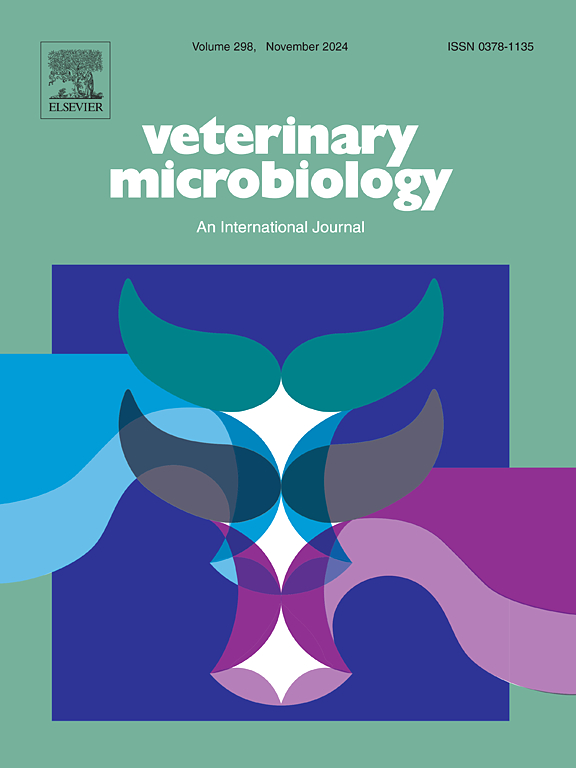New Delhi Metallo-beta-lactamase-5-producing Escherichia coli ST48 isolated from Giant Anteater (Myrmecophaga tridactyla)
IF 2.4
2区 农林科学
Q3 MICROBIOLOGY
引用次数: 0
Abstract
Carbapenemase-producing Escherichia coli are frequently related to healthcare-associated infections. Still, those have been reported from variable sources, including wild and zoo animals, posing a substantial threat to the conservation of animal species vulnerable to extinction. In this study, we reported an NDM-5-producing E. coli ST 48 isolated from rectal swab collected on April 21st, 2024 from a healthy Giant Anteater (Myrmecophaga tridactyla) in a Brazilian Zoo. The E. coli strain showed antimicrobial-resistant genes to quinolones, tetracyclines, and beta-lactams, including carbapenems, cephalosporins, and penicillins, besides a wide range of virulence factors encoding genes. Phylogenomic analysis showed that the NDM-5-producing E. coli ST48 strain clustered with lineages from Myanmar and China. Its blaNDM-5 genetic context shared insertion sequences and adjacent genes with other ST48 strains. This is the first report of NDM-5-producing E. coli isolated from a zoo animal in Brazil, highlighting the potential to species conservation and the importance of monitoring antimicrobial-resistant bacteria in zoo animals.
产金属- β -内酰胺酶5大肠杆菌ST48分离自巨食蚁兽(Myrmecophaga triidactyla)
产碳青霉烯酶的大肠杆菌经常与卫生保健相关感染有关。尽管如此,据报道,这些动物来自各种来源,包括野生动物和动物园动物,对濒危动物物种的保护构成了重大威胁。在这项研究中,我们报道了从2024年4月21日采集的巴西动物园一只健康的巨食蚁兽(Myrmecophaga tridactyla)的直肠棉签中分离到一株产ndm -5的大肠杆菌ST 48。大肠杆菌菌株显示出对喹诺酮类药物、四环素类药物和β -内酰胺类药物的耐药基因,包括碳青霉烯类、头孢菌素类和青霉素类药物,此外还有广泛的毒力因子编码基因。系统基因组分析显示,产ndm -5的大肠杆菌ST48菌株聚集在缅甸和中国的谱系中。其blaNDM-5遗传背景与其他ST48菌株共享插入序列和邻近基因。这是从巴西动物园动物中分离到产生ndm -5的大肠杆菌的第一份报告,突出了物种保护的潜力和监测动物园动物中耐药细菌的重要性。
本文章由计算机程序翻译,如有差异,请以英文原文为准。
求助全文
约1分钟内获得全文
求助全文
来源期刊

Veterinary microbiology
农林科学-兽医学
CiteScore
5.90
自引率
6.10%
发文量
221
审稿时长
52 days
期刊介绍:
Veterinary Microbiology is concerned with microbial (bacterial, fungal, viral) diseases of domesticated vertebrate animals (livestock, companion animals, fur-bearing animals, game, poultry, fish) that supply food, other useful products or companionship. In addition, Microbial diseases of wild animals living in captivity, or as members of the feral fauna will also be considered if the infections are of interest because of their interrelation with humans (zoonoses) and/or domestic animals. Studies of antimicrobial resistance are also included, provided that the results represent a substantial advance in knowledge. Authors are strongly encouraged to read - prior to submission - the Editorials (''Scope or cope'' and ''Scope or cope II'') published previously in the journal. The Editors reserve the right to suggest submission to another journal for those papers which they feel would be more appropriate for consideration by that journal.
Original research papers of high quality and novelty on aspects of control, host response, molecular biology, pathogenesis, prevention, and treatment of microbial diseases of animals are published. Papers dealing primarily with immunology, epidemiology, molecular biology and antiviral or microbial agents will only be considered if they demonstrate a clear impact on a disease. Papers focusing solely on diagnostic techniques (such as another PCR protocol or ELISA) will not be published - focus should be on a microorganism and not on a particular technique. Papers only reporting microbial sequences, transcriptomics data, or proteomics data will not be considered unless the results represent a substantial advance in knowledge.
Drug trial papers will be considered if they have general application or significance. Papers on the identification of microorganisms will also be considered, but detailed taxonomic studies do not fall within the scope of the journal. Case reports will not be published, unless they have general application or contain novel aspects. Papers of geographically limited interest, which repeat what had been established elsewhere will not be considered. The readership of the journal is global.
 求助内容:
求助内容: 应助结果提醒方式:
应助结果提醒方式:


